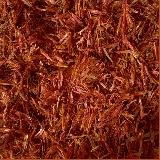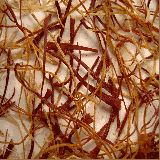| common name | Carthamus Hong Hua |
| alias | Safflower Chuan Hong Hua |
This product is the flower of the annual herbaceous plant Carthamus (Carthamus tinctorius L.) of the Asteraceae family. It is widely cultivated across the country, mainly produced in Henan, Zhejiang, Sichuan, Jiangsu, and other regions. The flowers are picked when they turn from yellow to red in summer, then dried in the shade or under the sun, and used raw.



bubble_chart Properties and Meridians
Acrid, warm. Act on heart and liver meridians.
Invigorating the blood to unblock meridians, resolving stasis to stop pain.
- Used for blood stasis amenorrhea, dysmenorrhea, postpartum stasis abdominal pain, etc. This product is pungent and dispersing, warm and unblocking, specifically entering the blood aspect, with the function of invigorating blood and resolving stasis, regulating the Jingmai. It is often combined with Peach Kernel, Chinese Angelica, Sichuan Lovage Rhizome for mutual reinforcement. For amenorrhea, it is combined with Chinese Angelica, Zedoary Rhizome, Cassia Bark, etc., such as Infradiaphragmatic Stasis-Expelling Decoction; for dysmenorrhea, it can be combined with Red Peony Root, Corydalis Tuber, Cyperus, etc., to regulate qi and resolve stasis to relieve pain. It can also be used alone, such as Jingui Yaolue's Red Flower Wine, which is this product decocted with wine, to treat stabbing pain in the abdomen due to blood and qi stasis.
- Used for abdominal mass, heart and abdominal stasis pain, and traumatic injuries, blood vessel occlusion with purple swelling and pain, etc. This product can invigorate blood and resolve stasis, eliminate masses, unblock blood vessels, and subdue swelling to relieve pain. For masses, it is combined with Sparganium Rhizome, Zedoary Rhizome, etc.; for traumatic injuries, stasis swelling and pain, it is combined with Sappan Wood, frankincense, myrrh, etc.; or Carthamus tincture, Carthamus oil can be applied to treat heart vessel stasis obstruction, chest impediment, combined with Cinnamon Twig, Trichosanthis Fruit, Salvia, etc.; in modern times, it is used alone in tablet or injection form to treat coronary heart disease, with certain efficacy in alleviating angina and improving electrocardiogram; Carthamus injection is used intravenously to treat cerebral thrombosis and thrombotic vessel inflammation, and for thrombotic vessel inflammation, it can also be combined with Chinese Angelica, Red Peony Root, frankincense, myrrh, etc.
- Used for dark macula and papule, heat stagnation blood stasis, this product's function of invigorating blood and dissipating ecchymosis is taken, with saffron crocus style and stigma being superior, as it is cool in nature and has the function of cooling blood to remove toxins. It is often combined with Chinese Angelica, Arnebia, Dyers Woad, etc., to invigorate blood, cool blood, and remove heat toxins. Such as in "Maco Huoren Shu" Chinese Angelica Carthamus drink. In modern times, Carthamus injection is used intramuscularly to treat polymorphic erythema.
- "Xinxiu Benli": "Treats lockjaw and muteness, blood stasis, and various postpartum diseases."
- "Bencao Yanyi Buyi": "Carthamus, breaks stagnant blood, nourishes blood. Excessive use breaks blood stasis, while moderate use finely nourishes blood."
- "Bencao Gangmu": "Activates blood, moistens dryness, relieves pain, reduces swelling, and promotes menstruation."
Decoct and take 8-9g; apply an appropriate amount externally.
bubble_chart Cautions and Contraindications
Pregnant women should avoid taking it, and those with a tendency to bleed should not use it excessively.
bubble_chart Modern Pharmacology
This product contains Carthamus flavone, Carthamus glycosides, Carthamus pigment, Carthamus quinone glycosides, and new Carthamus glycosides. It also contains Carthamus oil, primarily composed of Windmill Palm acid, stearic acid, peanut acid, oleic acid, linoleic acid, and others. The water extract of Carthamus has a grade I effect on stimulating the heart and increasing coronary flow. Carthamus alleviates acute myocardial ischemia in dogs, slows the heart rate, and significantly reduces the elevation of the S-T segment in the electrocardiogram. Carthamus flavone has a certain antagonistic effect on arrhythmias caused by Aconite Mother Root alkaloids and exhibits varying degrees of hypotensive effects in anesthetized animals. It inhibits platelet aggregation and increases fibrinolysis. The decoction has an excitatory effect on the uterus of various animals, whether pregnant or not, and can even cause spasms, with a particularly pronounced effect on the pregnant uterus. Additionally, Carthamus oil has the effect of reducing blood lipids.
bubble_chart Supplementary MedicinalsSaffron crocus style and stigma: The stigma of the perennial herb saffron crocus (Crocus sativus L.) from the iris family. Also known as saffron crocus style and stigma. It is native to Europe and Central Asia. Traditionally imported from India and Iran via Tibet, it is now also cultivated in China. It has a sweet and slightly cold nature. It acts on the heart and liver meridians. It has a blood-invigorating and stasis-resolving effect similar to Carthamus, but with stronger potency, and also possesses the ability to cool blood and remove toxins. It is particularly suitable for warm febrile diseases with heat invading the blood aspect, heat stagnation and blood stasis, and spots that are not bright red. Decoction dosage: 1-1.5g. Contraindicated for pregnant women.
bubble_chart Other Related Items




